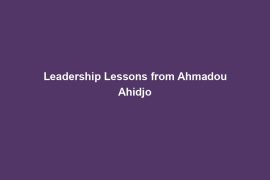As we dive into the world of presidential leadership, one name that stands out is Paul Biya, the long-standing president of Cameroon. Known for his decades-long presidency, Biya’s leadership style has both intrigued and perplexed many. But why should we care about studying his leadership? Well, for aspiring leaders, understanding the strategies and decisions of past leaders like Biya can offer valuable insights into effective leadership practices.
In this blog post, we will analyze key leadership lessons that can be derived from Paul Biya’s leadership style and decisions. By examining how Biya has managed to maintain power, overcome challenges, and shape his public image, we can uncover valuable lessons that can be applied to our own leadership journeys.
So, get ready to explore the world of presidential leadership through the lens of Paul Biya’s experiences. Let’s uncover the secrets to consensus-building, adaptability, resilience, communication, and more. Are you ready to uncover the leadership gems hidden within Biya’s tenure? Let’s dive in and unlock the lessons that can shape our own leadership practices.
Leadership Lessons from Paul Biya
Now that we have a better understanding of Paul Biya’s background and presidency, let’s delve into the key leadership lessons that can be derived from his leadership style. Whether you aspire to be a leader in politics, business, or any field, studying the decisions and strategies of past leaders like Biya can provide valuable insights into effective leadership practices.
Consensus-building and Coalition Management
One of the most striking aspects of Paul Biya’s leadership style is his ability to maintain power through building alliances with various political factions and interest groups. By forming coalitions and seeking consensus, Biya has been able to navigate the complex political landscape of Cameroon and stay in power for decades. However, this approach also has its drawbacks, as it can sometimes lead to compromises that may not always align with one’s values or principles.
Adaptability and Resilience
Biya’s ability to adapt to evolving political situations and his resilience in the face of challenges are also noteworthy leadership lessons to be learned. Throughout his presidency, Biya has been able to navigate political crises and maintain stability in Cameroon, showcasing his ability to weather storms and emerge stronger. Leaders facing similar situations can draw inspiration from Biya’s response to challenges and apply similar strategies in their own leadership roles.
Communication and Public Image
Effective communication is a cornerstone of successful leadership, and Biya’s communication strategies offer valuable insights into the importance of maintaining a positive public image. By evaluating Biya’s communication tactics and their impact on his public perception, aspiring leaders can learn how to improve their own communication skills and effectively convey their messages to the public.
By analyzing these key leadership lessons from Paul Biya’s leadership style, we can gain a deeper understanding of what it takes to be an effective leader in today’s world. Stay tuned for the conclusion, where we will recap the main takeaways from this analysis and discuss the importance of implementing these lessons in your own leadership practices.
Conclusion
So, what can we learn from Paul Biya’s leadership style? Let’s recap the key leadership lessons we’ve uncovered in this analysis.
Reflecting on Leadership Practices
First and foremost, Biya’s emphasis on consensus-building and coalition management teaches us the importance of forging alliances and working together towards common goals. By building relationships with different political factions and interest groups, he was able to maintain stability and power in Cameroon. As aspiring leaders, we can learn from his approach and strive to build strong partnerships within our own organizations.
Adaptability and Resilience
Biya’s ability to adapt and navigate through political crises shows us the importance of staying resilient in the face of challenges. Just like Biya, we too may encounter obstacles along our leadership journey. It’s essential to remain flexible, think on our feet, and find creative solutions to overcome hurdles that come our way.
Effective Communication
Lastly, Biya’s communication strategies highlight the significance of clear and effective communication in leadership. By communicating openly and transparently with the public, leaders can build trust and credibility with their followers. It’s crucial for us to hone our own communication skills, whether through public speaking, writing, or engaging with others, to become more impactful and influential leaders.
Takeaways for Future Leaders
As we wrap up, I encourage you to reflect on your own leadership practices and consider implementing the lessons learned from this analysis of Paul Biya’s leadership style. By studying past leaders like Biya, we can gain valuable insights into effective leadership strategies that can guide us on our own leadership journey. So, why not take a moment to think about how you can apply these lessons in your own leadership roles? Who knows, you might just unlock the key to becoming a more effective and successful leader in the future!
Thank you for joining me on this exploration of leadership lessons from Paul Biya. I hope you found this analysis insightful and inspiring. Here’s to unlocking our full leadership potential and making a positive impact on the world around us!

